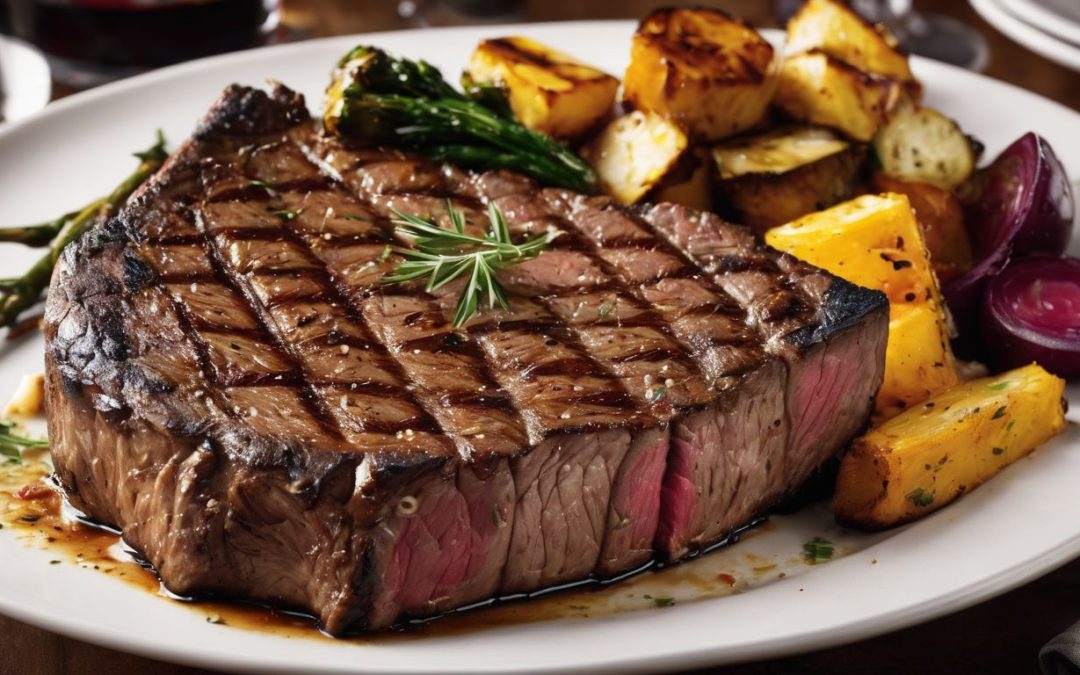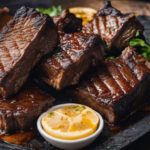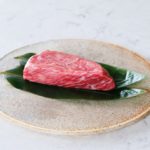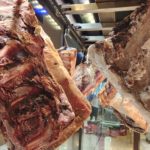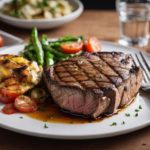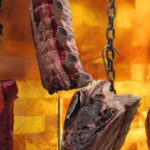Confused about what sets Porterhouse and T-bone steaks apart? You’re not alone – these two premium cuts of steak are often mistaken due to their similar appearance. However, they originate from different parts of a cow’s short loin and vary in size, thickness, and flavor profile.
This article is your definitive guide to understanding the distinctive qualities of these two mouth-watering steak staples. Ready for some tasty enlightenment? Let’s dive into the succulent world of Porterhouse and T-bone steaks!
Key Takeaways
- Porterhouse steak and T – bone steak look similar but come from different parts of the cow’s short loin.
- The porterhouse has a larger tenderloin filet compared to the T – bone, making it thicker and juicier.
- Both steaks have a rich flavor, tenderness, and high protein content, but the porterhouse is generally more expensive due to its size and filet portion.
- When cooking these steaks, grilling, pan-searing, oven-baking, or using sous vide are popular methods.
Origins and Definitions of Porterhouse and T-Bone Steaks
Porterhouse steaks come from the cow’s rear end of the short loin. This cut gives us a big steak with lots of tasty meat. On one side of its T-shaped bone, there is strip steak. On the other side, you find a tenderloin filet.
It also has a good size which makes it thick.
T-bone steaks are cut close to where porterhouse steaks are cut from. They also have this T-shaped bone in them. The strip steak and tenderloin present on both sides make this steak rich in flavor too! But here, the tenderloin part is smaller than what we see in porterhouse cuts.
So they are not as thick as porterhouses but still very loved by meat eaters all over!
Key Differences Between Porterhouse and T-Bone Steaks
Porterhouse and T-bone steaks differ in their location of the cut, filet size and source, appearance and thickness, taste and texture, nutritional profile, and marbling quality.
Location of the Cut
Porterhouse and T-bone steaks come from different parts of the cow. The porterhouse steak is cut from the rear end of the short loin, while the T-bone steak comes from a similar area.
They both have a “T-shaped” bone in the middle, with meat on each side. On one side of the bone, you’ll find strip steak in both cuts. However, on the other side of the bone, the porterhouse has a larger tenderloin filet compared to the T-bone.
So, depending on where they come from on the cow, these steaks have slightly different amounts of meat and fat distribution.
Filet Size and Source of Cut
Porterhouse and T-bone steaks have different sizes of filet and come from different parts of the cow. The filet in a porterhouse steak is larger than in a T-bone steak. In a porterhouse, you’ll get a bigger piece of tenderloin filet on one side of the bone, while in a T-bone, it’s smaller.
These steaks are cut from the rear end of the short loin, but they come from different ends. So if you want more tenderloin meat, go for the porterhouse!
Appearance and Thickness
Porterhouse steaks and T-bone steaks look pretty similar, but there is one noticeable difference in their appearance: thickness. The porterhouse steak is generally thicker than the T-bone steak.
This means that when you cook a porterhouse steak, it will take a bit longer to reach your desired level of doneness compared to a T-bone steak. The thickness also affects the overall flavor of the meat.
Since the porterhouse is thicker, it tends to have a richer and more robust flavor. So if you’re someone who likes a thick and juicy steak, then the porterhouse might be the perfect choice for you!
Taste and Texture
Porterhouse and T-bone steaks have similar taste and texture, but there are some slight differences. Both cuts are known for their tenderness and delicious flavor. The strip steak side of the porterhouse and T-bone has a hearty, beefy taste with good marbling that adds juiciness to each bite.
The tenderloin filet side is more delicate, with a buttery smooth texture and a milder flavor. This filet section is larger in the porterhouse compared to the T-bone, so you’ll get even more of that melt-in-your-mouth goodness.
Whether you prefer a richer, meatier taste or a softer, more subtle experience, both cuts offer something tasty for every steak lover’s palate.
Nutritional Comparison
When we talk about the nutritional value of Porterhouse and T-bone steaks, they’re fairly similar, yet some differences exist.
| Porterhouse Steak (3oz serving) | T-bone Steak (3oz serving) | |
|---|---|---|
| Calories | 250 | 210 |
| Total Fat | 17g | 14g |
| Saturated Fat | 6g | 5g |
| Cholesterol | 67mg | 58mg |
| Sodium | 55mg | 54mg |
| Protein | 21g | 18g |
The above table shows a comparison of the nutritional values of both Porterhouse and T-bone steaks. Please note that these values can slightly change depending on the cooking method and the size of the steak. For example, a larger cut of Porterhouse steak will naturally contain more calories, fats, and proteins compared to a smaller T-bone steak. Both steaks have high protein content, making them excellent choices for those on protein-rich diets. Furthermore, these steaks, particularly the Porterhouse, provide a significant source of important vitamins and minerals, such as iron and vitamin B12.
Marbling and Quality Grades
Marbling refers to the small flecks of fat that are found within the muscle of a steak. It looks like white streaks throughout the meat. Marbling is important because it adds flavor and makes the meat more tender when it cooks.
The more marbling a steak has, the better quality it is considered to be. When you see steaks labeled as “Prime,” “Choice,” or “Select,” these are different grades based on marbling.
Prime steaks have the most marbling and are usually the highest quality, while Select steaks have less marbling and may not be as tender or flavorful. So, if you want a really good steak with lots of flavor, look for one with lots of marbling!
Price Comparison: Porterhouse vs T-Bone
Porterhouse and T-bone steaks are both premium cuts of beef, but there can be a difference in price. The price of these steaks can vary depending on factors such as quality, grade, and where you buy them. Generally, because Porterhouse steaks are larger and include more tenderloin filet compared to T-bone steaks, they tend to be priced higher. However, the exact prices can differ between different stores or suppliers. It’s always a good idea to compare prices at different places before making a purchase if you’re looking for the best deal. So whether you choose a Porterhouse or T-bone steak, make sure to check out the prices so that you get the most value for your money when indulging in these delectable cuts of meat.
[Total Words: 133]
Cooking Methods and Recipes for Porterhouse and T-Bone Steaks
Porterhouse and T-bone steaks are both delicious and can be cooked in various ways. Here are some cooking methods and recipes for these mouth-watering steaks:
- Grilling: Preheat the grill to high heat. Season the steak with salt, pepper, and your favorite seasonings. Place it on the hot grill and cook for about 4-5 minutes per side for medium-rare doneness.
- Pan-searing: Heat a cast-iron skillet over high heat. Rub the steak with olive oil, salt, and pepper. Place it in the hot skillet and sear for 2-3 minutes on each side. Reduce the heat to medium-high and continue cooking until desired doneness.
- Oven-baking: Preheat the oven to 425°F (218°C). Season the steak with your preferred spices. Heat an oven-safe skillet over high heat, then sear the steak for 1-2 minutes on each side. Place the skillet in the preheated oven and bake for about 6-8 minutes for medium-rare steaks.
- Sous vide: Fill a large pot or container with water and set your sous vide machine to 130°F (54°C) for medium-rare or adjust as desired. Season your steak with salt, pepper, and any other desired seasonings, then vacuum-seal it or place it in a ziplock bag using the water displacement method. Cook the steak sous vide for around 2 hours.
- Recipes: Try making a classic steakhouse-style meal by serving Porterhouse or T-bone steaks with garlic mashed potatoes, grilled asparagus, and a red wine reduction sauce on top.
Tips for Choosing the Best Cut and Conclusion
When choosing between a porterhouse and T-bone steak, remember that they are both delicious options. Consider your preferences for filet size, bone thickness, and price. No matter which one you choose, both cuts will offer a tender and flavorful dining experience.
Enjoy your steak!
FAQs
Q: What is the difference between a porterhouse and a T-bone steak?
A: The main difference between these two steaks lies in the size of the tenderloin muscle. While both cuts come from the short loin and include a T-shaped bone with meat on each side, the porterhouse steak has a larger portion of tenderloin compared to the T-bone steak.
Q: How are porterhouse and T-bone steaks cut?
A: Both porterhouse and T-bone steaks are cut from the short loin of the animal. They are both cross-sections of the same primal cut, with the main difference being the size of the tenderloin muscle.
Q: What is the difference between a porterhouse steak and a T-bone steak?
A: The key difference between a porterhouse and a T-bone steak is the size of the tenderloin muscle. A porterhouse steak contains a larger portion of tenderloin compared to a T-bone steak.
Q: How do porterhouse and T-bone steaks taste?
A: Both porterhouse and T-bone steaks have a similar taste profile. They are both flavorful cuts of steak that are known for their tenderness and rich beefy flavor. The taste may vary slightly depending on the cooking method and seasonings used.
Q: How do I choose between a porterhouse and a T-bone steak?
A: When choosing between a porterhouse and a T-bone steak, consider the size of the tenderloin muscle and your personal preference. If you prefer a larger portion of tenderloin, go for the porterhouse steak. If you prefer a smaller portion of tenderloin, opt for the T-bone steak.
Q: Can I use an alternative to porterhouse steak?
A: Yes, if you cannot find a porterhouse steak, you can use a T-bone steak as an alternative. While they are not exactly the same, they are very similar cuts and can be used interchangeably in most recipes.
Q: How should I cook a porterhouse steak?
A: To cook a porterhouse steak, start by seasoning it with salt and pepper or your preferred steak seasoning. Grill or sear the steak over high heat for a few minutes on each side until it reaches your desired level of doneness. Let the steak rest for a few minutes before serving to allow the juices to redistribute.
Q: Can a T-bone steak be considered a porterhouse?
A: No, a T-bone steak cannot be considered a porterhouse. While the two cuts are very similar, a porterhouse steak has a larger portion of tenderloin muscle, whereas a T-bone steak has a smaller portion.
Q: What is the cost difference between porterhouse and T-bone steaks?
A: The cost difference between porterhouse and T-bone steaks may vary depending on factors such as the quality of the meat and the location. Generally, porterhouse steaks tend to be more expensive due to the larger portion of tenderloin.
Q: What makes a porterhouse steak different from a T-bone steak?
A: The main difference between a porterhouse steak and a T-bone steak is the size of the tenderloin muscle. A porterhouse steak contains a larger portion of tenderloin, while a T-bone steak has a smaller portion.
Greetings!
With over two decades of diverse experience in the meat industry, I proudly stand as an expert in all things meat. My journey commenced with a strong foundation in hospitality, where I honed my culinary skills as a chef in prestigious restaurants and on luxurious superyachts worldwide.
However, my true passion lies in the art of butchery. Throughout my extensive career, I have had the privilege of working with renowned meat purveyors and mastering the craft of meat cutting and preparation. From breaking down whole carcasses to meticulously selecting prime cuts, my butchery expertise is at the core of my meat knowledge.
Having immersed myself in various cultures and cuisines, I have honed my skills to deliver exceptional dining experiences, crafting delectable dishes that celebrate the natural flavors of different meats. Whether it's sourcing the finest meats for discerning clients or sharing valuable tips on meat selection and cooking, I take pride in elevating the meat experience for both professionals and enthusiasts.
My journey has taken me from the bustling kitchens of top-rated restaurants to the heart of meat processing facilities, gaining insights and honing my skills to become a true meat connoisseur. Now, I am enthusiastic about sharing my expertise, offering valuable insights on meat selection, cooking techniques, and the art of butchery.

